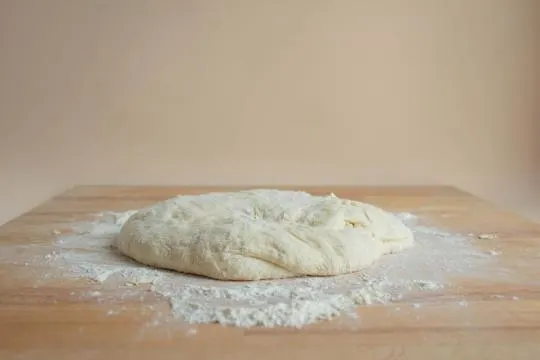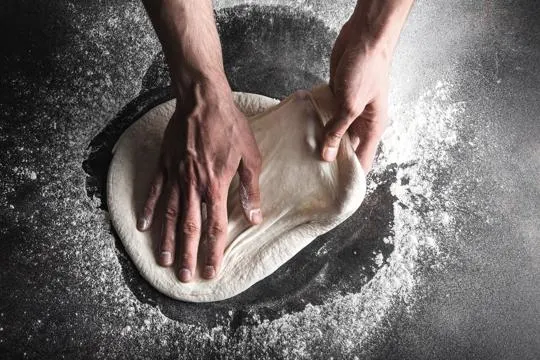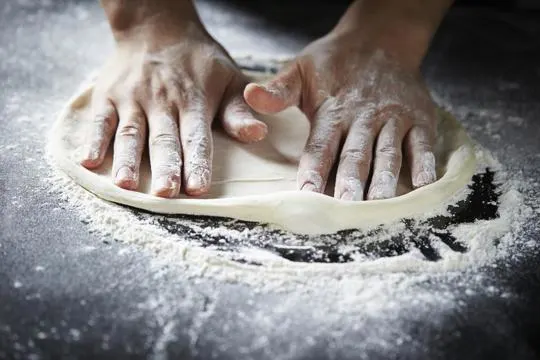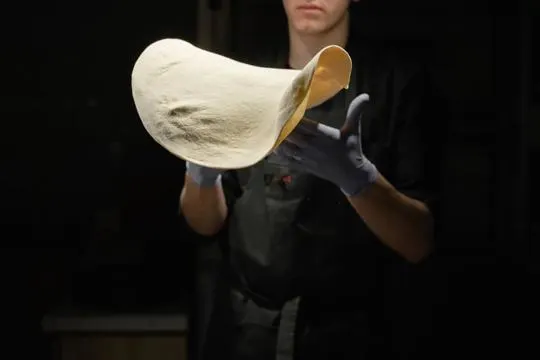Summary of key points
The main difference between calzone dough and pizza dough is in their shape and method of preparation. Calzone dough is typically rolled out into a circle, folded in half to create a pocket, and then filled with ingredients before being baked. Pizza dough is stretched or rolled into a thin round shape and topped with ingredients before baking.
In terms of texture, calzones have a thicker and chewier crust compared to pizzas which have a thinner and crispier crust. Both types of dough are made from similar ingredients such as flour, yeast, water, and oil but may differ in the amount used depending on the desired consistency.
When it comes to serving, calzones are often served as a single portion while pizzas can be shared among multiple people. Both options offer endless possibilities for fillings and toppings, making them versatile and delicious meal choices.
Ah, the age-old kitchen debate. Calzone dough vs. pizza dough. Fact: they start the same. Surprise, right?
Now, we all think, “It’s just dough!” That’s where the plot thickens. One wraps its goodness inside, the other flaunts it. It’s the inside vs. outside showdown.
In our many kitchen escapades, we’ve laughed and cried over dough. It’s sticky, it’s tricky, it messes with you. Yet, we persist.
Here’s the lowdown. They differ, not just in shape. It’s about moisture, texture, and how they bake. Keep reading. It’s enlightening, really.
What is Calzone Dough?

Calzone dough makes this Italian dish delicious.
It’s made with flour, water, yeast, olive oil, and salt.
Knead it until it’s soft and elastic. Let it rise, and stuff it with cheese, veggies, or meats.
Bake it to perfection. The special thing about calzone dough is that it seals up the fillings in a neat package.
Unlike pizza dough, calzone dough forms a pocket that keeps the flavor and moisture inside.
The texture of calzone dough is thicker than pizza dough. It’s crispy on the outside and chewy inside.
Calzone dough is so versatile. You can encase an entire meal in one serving.
Plus, it’s portable and convenient.
To make the best calzone dough, pay attention to the ingredients and process.
The right amount of gluten development helps the dough to stretch and stay sturdy.
What is Pizza Dough?

Pizza dough is the base of a tasty pie.
It’s a mix of simple ingredients – flour, water, yeast, and salt.
Kneading them together forms a cohesive ball.
This is important, as it allows gluten to develop, giving the dough its stretchy, chewy feel.
Next is “proofing”, which is the process that lets the dough rise.
The yeast ferments, releasing carbon dioxide, which causes the dough to puff up and become airy.
This gives pizzas their signature lightness and fluffiness.
Achieving the right balance of elasticity and structure is the key to a good pizza dough.
Too much gluten can create a tough, chewy crust.
Not enough gluten and you’ll get a thin, frail base.
Plus, different regions in Italy have their own variations of pizza dough.
Neapolitan-style pizza has a soft center and charred edges, due to its highly hydrated dough with minimal yeast, cooked in high heat in a wood-fired oven.
New York-style pizza has higher gluten content, creating a chewier texture.
Ingredients Used in Calzone Dough and Pizza Dough
Calzone dough and pizza dough may appear alike.
They have similar ingredients like flour, yeast, water, salt, and olive oil.
But their proportions and techniques are different.
Calzone dough recipes usually call for more oil, to give a soft and flexible texture.
This makes the crust tender when baked.
Pizza dough requires a longer fermentation period, for a more pronounced flavor.
Calzone dough may use faster-rise yeast or a shorter rising time for a lighter texture.
Some pizza dough recipes use sugar for browning and caramelization.
Calzone dough often doesn’t include it, as the filling is usually sweet enough.
When you want Italian food, picking the right type of dough is essential.
Whether it’s calzone or pizza, remember to choose the correct dough for culinary greatness.
Differences Between Calzone Dough and Pizza Dough

Calzone and pizza dough may appear similar, but they have some key variations.
The ingredients are alike, yet the ratios and preparation methods make them distinct.
Texture and Thickness
Calzone dough and pizza dough differ in texture and thickness.
Calzone dough is thick and dense, like bread.
It gives a filling and satisfying feeling when eaten. It’s also chewy.
Pizza dough, on the other hand, is thin and light. This makes it crispy as it bakes.
It provides a crunch for pizza lovers.
Calzone dough has a more substantial texture.
It holds the filling in place, giving a great taste every bite.
Pizza dough, on the other hand, is thin and crispy.
It makes a good base for toppings and flavors. It all comes down to personal preference.
Calzone or pizza? They both have their own unique textures and thickness.
These qualities make for an interesting dining experience. Which will you choose?
Filling and Toppings
Calzone dough and pizza dough differ in their fillings and toppings.
Both can include cheese, sauce, and other toppings.
But the way they’re arranged is what sets them apart.
In a calzone, the fillings are enclosed in the dough – creating a pocket-like shape.
This allows for a blend of flavors as they bake together.
The fillings can be classic combos like mozzarella and pepperoni or creative ones like spinach and feta.
Pizza dough is typically topped with ingredients spread out evenly.
The toppings mix together during baking – providing more flavor and texture options.
Calzones and pizzas both offer endless possibilities for fillings and toppings.
But their different structures create unique eating experiences.
So, whatever you prefer – a neat bundle or a savory mix – there’s something yummy waiting for you.
Shape and Folding
Calzone and pizza dough have distinct differences when it comes to shape and folding.
Calzone dough is usually folded into a half-moon shape, creating a pocket.
Pizza dough is stretched out into a round shape.
This difference in shape provides different culinary experiences.
Folding techniques also differ. Calzone dough is folded over itself and sealed along the edges.
This way, all the flavors stay locked inside.
Pizza dough is left unfolded, so toppings are evenly spread.
Plus, baking processes are different for each type of dough.
Calzones are usually baked until golden-brown.
This gives the outside a crispiness and the inside a gooeyness.
Pizzas are baked at high temperatures for a short time, making the crust chewy and crispy.
Cooking Method
Cooking technique is a major factor in a dish’s taste and texture.
Calzone dough and pizza dough have different methods.
Pizza is usually cooked on a stone hearth or in a wood-fired oven, while calzones can be deep-fried or baked.
This explains why they have different characteristics and flavors.
Pizza’s thin and crispy crust requires high heat.
Baking it in a hot oven causes the dough to rise, making air pockets.
This results in a mix of flavors with melted cheese, savory sauce, and browned crust.
Calzones are special as they enclose all ingredients in a folded pocket of dough.
They are also more portable.
Deep-frying them provides a golden exterior and seals in the flavors.
Baking gives them a lighter version with a crisp outer layer.
Both calzone and pizza dough have similar bases – flour, water, yeast, salt.
But, their cooking methods create distinct nuances.
To better enjoy these dishes, it helps to understand the differences.
Similarities Between Calzone Dough and Pizza Dough

Calzone and pizza dough have some things in common.
Both are made with flour, water, yeast, and salt.
They need to be mixed until they form a smooth dough.
Then, they must rest and rise, allowing the yeast to do its job.
These two doughs are also multi-purpose.
Pizza dough is usually for traditional toppings, but it can also be a calzone base.
But, there are distinctions.
Calzone dough is thicker than pizza dough so fillings won’t leak.
It may contain fat or oil, too, for more flavor.
Pizzas bake on a stone or sheet, while calzones are folded into half-moons before baking.
In conclusion, calzone and pizza dough have similarities and differences.
Knowing these will help you make delicious pizzas and calzones.
Tips for Making the Perfect Calzone Dough and Pizza Dough
Ah, the sweet aroma of freshly-baked calzones and pizzas.
To guarantee you make the perfect dough for each, follow these tips:
- Select High-Protein Flour: For a light yet chewy texture, opt for bread flour.
- Activate Yeast: To get a risen dough, make sure your yeast is fresh and active. Soak it in warm water with sugar.
- Rest the Dough: Patience is key. Allow the dough to rest for at least an hour for superior flavor and texture.
- Don’t Skimp on Olive Oil: Generous amounts of olive oil will enhance flavor and create a golden crust.
Plus, there are endless possibilities for toppings, cheeses, and sauces.
Get creative and let your taste buds explore.
With these tips in mind, you can now master both calzone and pizza dough like a pro.
Conclusion
After all the exploration and comparison between calzone dough and pizza dough, it is safe to conclude that there are plenty of differences between them.
Granted, both types of dough can be used to create savory and scrumptious dishes; however, pizzas have a much longer baking time than calzones do.
Furthermore, making pizzas involves forming a larger base while calzones involve sealing the dough over its stuffing.
Basically, pizza dough will provide you with thin crusts that support the toppings added on top while calzone doughs will provide you with thicker and chewier crusts.
Both types of cooked dishes have their own unique set of flavors, textures, and baking techniques which make each one special in its own way.
Consequently, your taste buds will remain excited.

Leave a comment